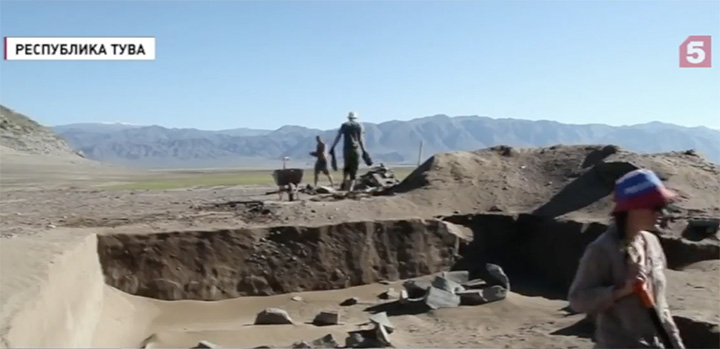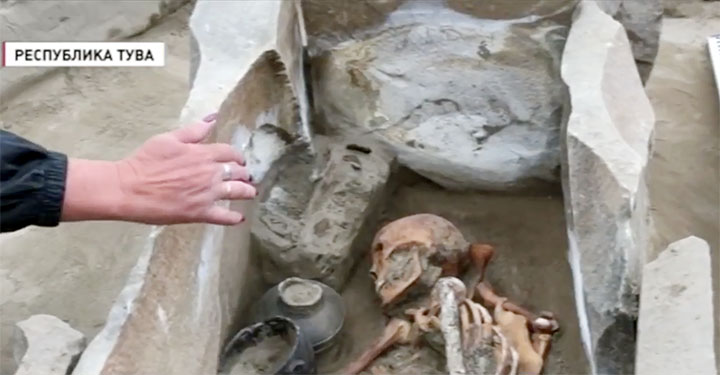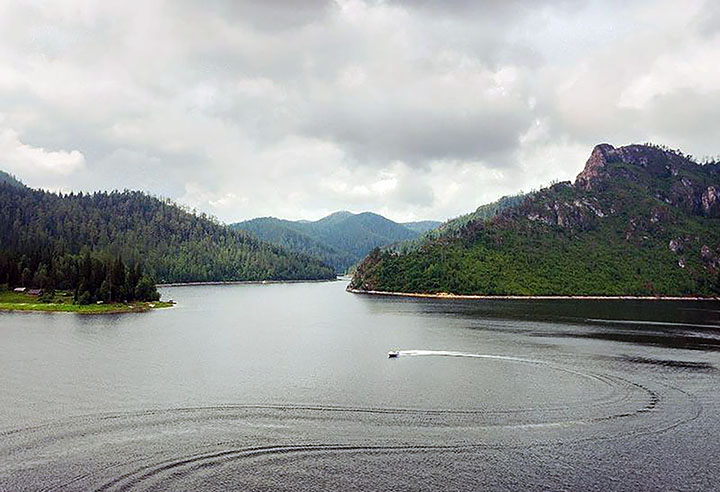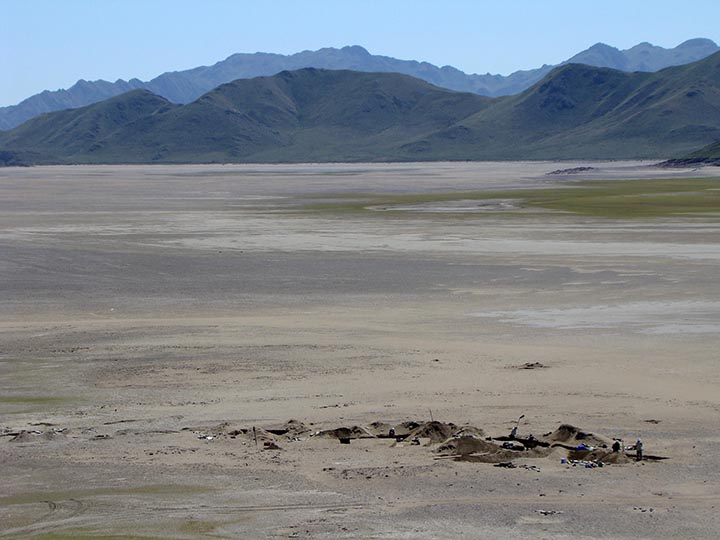Deleted
Deleted Member
Posts: 0
|
Post by Deleted on Jun 28, 2018 23:53:52 GMT -5
2,000 year old mummified ‘sleeping beauty’ dressed in silk emerges from Siberian reservoir, conclusion.  ‘This is not a classic mummy - in this case, the burial was tightly closed with a stone lid, enabling a process of natural mummification.’ Pictures: Channel 5She was buried around 1,900 to 2,000 years ago, scientists believe ahead of exhaustive tests. ‘This is not a classic mummy - in this case, the burial was tightly closed with a stone lid, enabling a process of natural mummification.’ Pictures: Channel 5She was buried around 1,900 to 2,000 years ago, scientists believe ahead of exhaustive tests.
Astonishingly, the remains were preserved even though they have been underwater for periods since the dam became operational between 1978-85.
Dr Solovieva said: ‘Near the head was found a round wooden box covered with birch-bark in which lay a Chinese mirror in a felt case.’
Near the young woman were two vessels, one a Hun-type vase.
 Terezin area. Terezin area. Sayano-Shushensk water reservoir. The shoreline of the reservoir when the water retreats. Sayano-Shushensk water reservoir. The shoreline of the reservoir when the water retreats.
There was a funeral meal in the vessels, and on her chest a pouch with pine nuts.'
Restoration experts have started working on the mummy.
Analysis of the find is expected to yield a wealth of information on her life and times.
Scientists received a grant from the Russian Geographical society to rescue the unique archeological finds in flooded areas.
|
|
|
|
Post by kemp on Jun 29, 2018 9:03:04 GMT -5
I remember reading somewhere else that the practise of bandaging skulls at birth to make them elongated was also done to differentiate the ruling caste from the rest of the population, but that may have been in reference to another people, something to do with cranial deformation of some of the Maya of ancient Mexico. The practise cropped up in the far east in different times and places. I would imagine that some of the Huns that sported cranial deformation looks would seem almost other worldly to European foes unaccustomed to the practise.  It's interesting to note that in the historical account of Priscus there's no mention of elongated skulls at the camp of Attila - he also encountered other prominent Hunnic leaders on his diplomatic mission for the Eastern Roman Empire. Great point Hun, yes, many of the descriptions on the physical appearance of the Huns as described by Roman writers concentrated on their central Asian appearance, although not very complementary, perhaps accentuating their ‘barbarian appearance’ Ammianus Marcellinus described the physical stature of the Huns: “…though they all have closely-knit and strong limbs, and plump necks; they are of great size, and low legged, so that you might fancy them two-legged beasts, or the stout figures which are hewn out in a rude manner with an axe on the posts at the end of bridges.” Jordannes made also his own description of the Huns: “They are short in stature, quick in bodily movement, alert horsemen, broad shouldered, ready in the use of bow and arrow, and have firm-set necks which are ever erect in pride. Though they live in the form of men, they have the cruelty of wild beasts.” It is a bit of a problem in identifying the actual eastern groups most responsible for cranial deformation of infants to produce that distinctive elongated head shape. I have come across sites dealing with the Huns from the Carpathian basin of Hungary, to Alans and other Sarmatians that might have practised a diverse range of binding styles. ‘Migrating Huns and modified heads: Eigenshape analysis comparing intentionally modified crania from Hungary and Georgia in the Migration Period of Europe’ www.ncbi.nlm.nih.gov/pmc/articles/PMC5289542/Cranial deformation of infants/young children probably originated in central Asia centuries before the Huns, and was also later practised by some of the Germanic peoples’ perhaps influenced from eastern peoples such as the aforementioned Huns. The Hun practise of placing binders in the heads of their young children to deform the skull probably resulted in what Jordannes described as ‘a sort of shapeless lump’ in his reference to the Huns, but the findings in the Carpathians and other parts of eastern Europe show that there was a greater variation in cranial deformation further east in locations such as Georgia. From the Natural History Museum of Hungary  |
|
|
|
Post by buxom9sorceress on Jun 29, 2018 9:13:18 GMT -5
Hey Hun. thanks for all the arrows + ruthless modu info.  those olde savage tales seem exaggerated for their olde oratory entertainment? |
|
Deleted
Deleted Member
Posts: 0
|
Post by Deleted on Jun 30, 2018 16:36:58 GMT -5
Here's a trailer for a new Russian movie: The Scythian (A.K.A. The Last Warrior) Skif (original title)
Released on Blu-ray, DVD and VOD platforms on August 14, 2018.
The Russian Trailer.
English Version.
Description thanks to IMDB.
These are times when one civilization is replacing another. A new era is about to begin in Central Eurasia. Scythians, the proud warriors, are all but gone. The few of their descendants have become ruthless mercenary assassins, the "waves of Ares." Lutobor, is a soldier with a difficult task at hand. He becomes involved in internecine conflicts and sets off on a perilous journey to save his family. His guide is a captive Scythian by the name of Weasel. Lutobor and Weasel are enemies. They pray to different gods but must embark on this journey together. They brave the wild steppes, moving toward the last haven of the Scythians, to what seems to be their inevitable demise.
Directed by Rustam Mosafir.
|
|
Deleted
Deleted Member
Posts: 0
|
Post by Deleted on Jun 30, 2018 16:42:29 GMT -5
Another trailer for the Scythian:
|
|
|
|
Post by Char-Vell on Jul 1, 2018 7:57:36 GMT -5
Here's a trailer for a new Russian movie: The Scythian (A.K.A. The Last Warrior) Skif (original title)
Released on Blu-ray, DVD and VOD platforms on August 14, 2018. The Russian Trailer. English Version. Description thanks to IMDB. These are times when one civilization is replacing another. A new era is about to begin in Central Eurasia. Scythians, the proud warriors, are all but gone. The few of their descendants have become ruthless mercenary assassins, the "waves of Ares." Lutobor, is a soldier with a difficult task at hand. He becomes involved in internecine conflicts and sets off on a perilous journey to save his family. His guide is a captive Scythian by the name of Weasel. Lutobor and Weasel are enemies. They pray to different gods but must embark on this journey together. They brave the wild steppes, moving toward the last haven of the Scythians, to what seems to be their inevitable demise. Directed by Rustam Mosafir. Looks real good! |
|
|
|
Post by kemp on Jul 1, 2018 15:12:09 GMT -5
Another trailer for the Scythian: The Scythians, the earliest of the groups that created central Asian nomadic empires or holds ( although no one organised state ), at least according to recorded history, displacing the earlier Cimmerians in the Pontic Steppe, and subsequently they developed quite a reputation as early mounted warriors. At one time dominating an area that stretched from the Carpathians in the west, all the way to central China ( Taklamakan finds ) and Siberia in the east, they were conquered in the west by another related group of central Asians we refer to as the Sarmatians, but held out in the east in various settlements for centuries longer ( Indo Scythians of South Asia ). I wonder if the film deals in part with the heroes journey to find these Scythian outposts/settlements in the far east, but perhaps the location is undisclosed. |
|
Deleted
Deleted Member
Posts: 0
|
Post by Deleted on Jul 3, 2018 18:23:37 GMT -5
Some pics from the upcoming Kazakh movie Tomyris.
www.imdb.com/title/tt7985648/Description from IMBD: This is the story of the life of the great queen of of the steppe - legendary Tomyris. She is destined to become a skillful warrior, survive the loss of close people and unite the Saka tribes under her authority.   With Almira Tursyn as Tomyris. .. and a couple of pics from the movie set.   Here's a link to a previous post on this thread concerning Tomyris. swordsofreh.proboards.com/post/3183/threadWikipedia link: en.wikipedia.org/wiki/Tomyris
|
|
|
|
Post by Char-Vell on Jul 4, 2018 13:40:52 GMT -5
Hello,LADIEEEEEEES!
I Gotta watch this!
|
|
|
|
Post by kemp on Jul 5, 2018 8:33:36 GMT -5
Some pics from the upcoming Kazakh movie Tomyris.
www.imdb.com/title/tt7985648/Description from IMBD: This is the story of the life of the great queen of of the steppe - legendary Tomyris. She is destined to become a skillful warrior, survive the loss of close people and unite the Saka tribes under her authority.   With Almira Tursyn as Tomyris. .. and a couple of pics from the movie set.   Here's a link to a previous post on this thread concerning Tomyris. swordsofreh.proboards.com/post/3183/threadWikipedia link: en.wikipedia.org/wiki/Tomyris She looks like a true Hyrkanian noble. Proud and born to rule. |
|
Deleted
Deleted Member
Posts: 0
|
Post by Deleted on Jul 18, 2018 15:21:49 GMT -5
There's not much out there on the Avars in the English language - and this is a very welcome translation of Walter Pohl's book on the often neglected Avars. Really looking forward to this one.  Walter Pohl (Translated by William Sayers), The Avars: A Steppe Empire in Central Europe, 567–822, Cornell University Press, 15 Dec 2018.The Avars arrived in Europe from the Central Asian steppes in the mid-sixth century CE and dominated much of Central and Eastern Europe for almost 250 years. Fierce warriors and canny power brokers, the Avars were more influential and durable than Attila’s Huns, yet have remained hidden in history. Walter Pohl’s epic narrative, translated into English for the first time, restores them to their rightful place in the story of early medieval Europe. Walter Pohl (Translated by William Sayers), The Avars: A Steppe Empire in Central Europe, 567–822, Cornell University Press, 15 Dec 2018.The Avars arrived in Europe from the Central Asian steppes in the mid-sixth century CE and dominated much of Central and Eastern Europe for almost 250 years. Fierce warriors and canny power brokers, the Avars were more influential and durable than Attila’s Huns, yet have remained hidden in history. Walter Pohl’s epic narrative, translated into English for the first time, restores them to their rightful place in the story of early medieval Europe.
The Avars offers a comprehensive overview of their history, tracing the Avars from the construction of their steppe empire in the center of Europe; their wars and alliances with the Byzantines, Slavs, Lombards, and others; and their apex as the first so-called barbarian power to besiege Constantinople (in 626); to their fall under the Frankish armies of Charlemagne and subsequent disappearance as a distinct cultural group. Pohl uncovers the secrets of their society, synthesizing the rich archaeological record recovered from more than 60,000 graves of the period, as well as accounts of the Avars by Byzantine and other chroniclers.
In recovering the story of the fascinating encounter between Eurasian nomads who established an empire in the heart of Europe and the post-Roman Christian cultures of Europe, this book provides a new perspective on the origins of medieval Europe itself.Here's another book on the Avars: Georgios Kardaras, Byzantium and the Avars, 6th-9th Century AD: Political, Diplomatic and Cultural Relations, Brill, 29th November 2019.
(I'll add cover when available) Description:
In this book, Georgios Kardaras offers a global view of the contacts between the Byzantine Empire and the Avar Khaganate, emphasizing the reconstruction of these contacts after 626 (when, in contrast to archaeological evidence, written sources are very few) and the definition of the possible channels of communication between the two powers. The author scrutinizes the political and diplomatic framework, and critically examines issues such as mutual influence on material culture and on warfare, reaching the conclusion that significant contact between Byzantium and the Avars can be proved up until 775.
www.amazon.co.uk/Byzantium-6th-9th-Century-Central-450-1450/dp/9004248382/ref=sr_1_3?s=books&ie=UTF8&qid=1531944937&sr=1-3&keywords=avars |
|
Deleted
Deleted Member
Posts: 0
|
Post by Deleted on Jul 30, 2018 1:31:46 GMT -5
The Sarıg Yugur, or Yellow Uygurs from Gansu, China
The Yugur tribe speak Turkic, Mongolian, Tibetan and Chinese!
The Yugur are considered as descendants of the Uygur Kaghanate, who were the ruling tribe of Mongolia between the years 745-840 AD.
Interesting video in the Yugur language with a dash of Chinese.
Yugur children's folk song [bilingual Chinese-Yugur Turkic]
|
|
Deleted
Deleted Member
Posts: 0
|
Post by Deleted on Jul 30, 2018 1:49:22 GMT -5
Trailer for the Yakut Zombie movie : Republic Z
|
|
|
|
Post by kemp on Jul 30, 2018 7:24:23 GMT -5
Trailer for the Yakut Zombie movie : Republic Z I really like the bit at the end where they drive out of the shed and mow down the zombies standing at the entrance.  |
|
Deleted
Deleted Member
Posts: 0
|
Post by Deleted on Aug 1, 2018 11:47:25 GMT -5
Kongurey (Where is my homeland?) is quite an emotional song about the nomad's yearning and love for their homeland.
There are several Turko-Mongol versions of this song, both appear to be in the original Tuvan language.
Doluma Çımbalak Kongurey
kongurey with Kongar-ool Ondar of Tuva, Russia and Daiqing Tana, she is a Mongolian singer from Qinghai, China. We'll see a couple more tunes from her later.
Here's the lyrics in the Tuvan language with English in italics.
Aldan cheteken chılgımıng
Of my horse herd of sixty
Alazı kaydal, Kongurey?
where are the dappled ones, Kongurey?
Aldı kozhuun chonumung
Of my people of the six banners,
Aalı kaydal, Kongurey?
Where are the encampments, Kongurey?
Cheden chetken chılgımıng
Of my horse herd that amount to seventy,
Chelezi kaydal, Kongurey?
Where are the tethers, Kongurey?
Chedi koyhuun chonumung
Of my people of the seven banners,
Cheri kaydal, Kongurey?
Where are my lands? Kongurey?
|
|